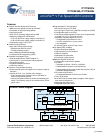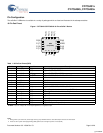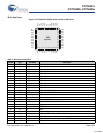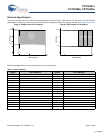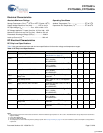
CY7C6431x
CY7C64345, CY7C6435x
Document Number: 001-12394 Rev *G Page 4 of 28
Designing with PSoC Designer
The development process for the enCoRe V device differs from
that of a traditional fixed function microprocessor. Powerful
PSoC Designer tools get the core of your design up and running
in minutes instead of hours.
The development process can be summarized in the following
four steps:
1. Select Components
2. Configure Components
3. Organize and Connect
4. Generate, Verify, and Debug
Select Components
The chip-level view provides a library of pre-built, pre-tested
hardware peripheral components. These components are called
“user modules.” User modules make selecting and implementing
peripheral devices simple, and come in analog, digital, and
mixed-signal varieties.
Configure Components
Each of the components you select establishes the basic register
settings that implement the selected function. They also provide
parameters and properties that allow you to tailor their precise
configuration to your particular application.
The chip-level user modules are documented in data sheets that
are viewed directly in PSoC Designer. These data sheets explain
the internal operation of the component and provide perfor-
mance specifications. Each data sheet describes the use of each
user module parameter and contains other information you may
need to successfully implement your design.
Organize and Connect
You build signal chains at the chip level by interconnecting user
modules to each other and the I/O pins, or connect system-level
inputs, outputs, and communication interfaces to each other with
valuator functions. In the chip-level view, you perform the
selection, configuration, and routing so that you have complete
control over the use of all on-chip resources.
Generate, Verify, and Debug
When you are ready to test the hardware configuration or move
on to developing code for the project, you perform the “Generate
Configuration Files” step. This causes PSoC Designer to
generate source code that automatically configures the device to
your specification and provides the software for the system.
Both system-level and chip-level designs generate software
based on your design. The chip-level design provides application
programming interfaces (APIs) with high level functions to
control and respond to hardware events at run time and interrupt
service routines that you can adapt as needed. The system-level
design also generates a C main() program that completely
controls the chosen application and contains placeholders for
custom code at strategic positions allowing you to further refine
the software without disrupting the generated code.
A complete code development environment allows you to
develop and customize your applications in C, assembly
language, or both.
The last step in the development process takes place inside
PSoC Designer’s Debugger (access by clicking the Connect
icon). PSoC Designer downloads the HEX image to the In-Circuit
Emulator (ICE) where it runs at full speed. PSoC Designer
debugging capabilities rival those of systems costing many times
more. In addition to traditional single-step, run-to-breakpoint and
watch-variable features, the debug interface provides a large
trace buffer and allows you to define complex breakpoint events
that include monitoring address and data bus values, memory
locations and external signals.
[+] Feedback



